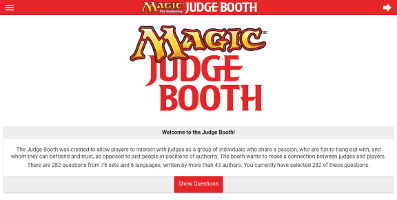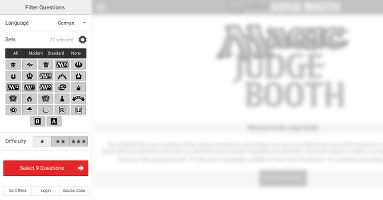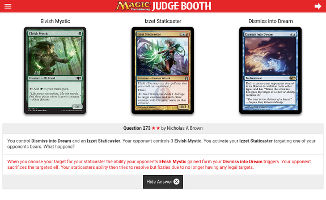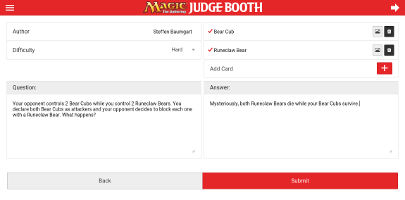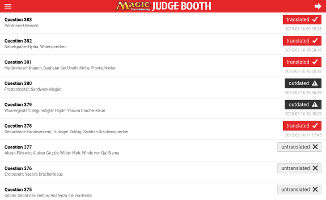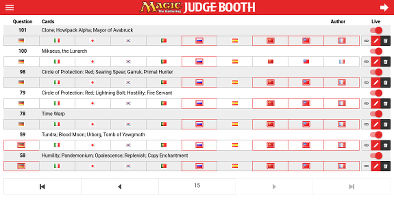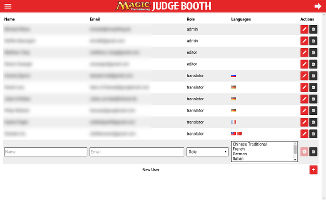This project provides a digital web-based version of the popular "Judge Booth" at bigger Magic: The Gathering(TM) events.
The booth wants to make a connection between judges and players by providing a diverse set of rules questions and testing the player's knowledge in a fun environment. The questions are available in 3 levels of difficulty and more than 5 different languages.
It is available online under booth.magicjudges.org to everyone and supports all internet-ready devices and screen sizes. If you discover a bug, please open a ticket!
Using the Judge Booth should be pretty self-explanatory. Once the website has loaded, you'll find a short introduction and a button that lets you start with questions right away on the home screen. If you want to customize your experience, there is a menu available on the left side of the booth. You can either open it by clicking on the left icon in the title bar, or by swiping the screen from left to right.
In the sidebar menu you'll finde several options to customize the list of questions.
- You can select from one of the available languages (English, German, French, Russian, Traditional Chinese, Simplified Chinese)
- You can choose from which expansions the questions should be selected. If you only want to see Standard or Modern legal cards, there is a quick filter for both available at the top of the expansion list.
- Finally, you can choose which difficulty levels to include in your list of questions. 1 star is "easy", 2 is "medium" and 3 is "hard".
After you made your choices, the big button below the filters will tell you how many questions fit your criterias. If there is at least 1 question available, you can click the "Select"-button and select these questions to use in the booth.
Once you're on the question page, you'll see a number of cards that are relevant for this question. If you want to see the oracle text for any of the cards, just click on the card image and it will flip to the "oracle text" side.
Note: Some foreign cards don't have images available, yet. You will see the back of the card in this case. To show the (English) Oracle text, just click on the card back.
Below the cards you will find the question number, the difficulty level (number of stars) and, if known, the author of the question, next to the question text itself. Show this question to the player and once they are sure of their answer, click on the "Show Answer" button to show the answer. Alternatively, you can also use the up/down arrow keys on your keyboard to show and hide the answer.
To go to the next question, click on the right arrow in the title bar, swipe the screen to the left or press the right arrow key on your keyboard. To go to the previous question, click the "Back" button in your browser or press the left arrow key on your keyboard.
Note: If you need to increase (or decrease) the size of the booth, just use your browser shortcuts, usually CTRL + Plus
or Command + Plus. (Minus for zooming out) The booth app has been built to scale seamlessly for bigger / smaller displays.
In case you don't have an internet connection where you want to set up the booth, there is an Offline Mode available. To use it, you have to click on Go Offline in the sidebar menu while you still have internet. You will then be taken to a slightly different URL, which you should bookmark for later when you're offline. After a couple of seconds, the necessary files will be downloaded and disconnecting your internet should leave you with a still-usable booth, minus the card images.
The Judge Booth comes with a powerful backend that allows you to quickly submit new questions, edit existing ones or create new translations. In order to authenticate you, it utilizes the Google API similar to how Google Docs works and requires that you have an email address associated with Google to use when logging in.
In order to log in, an admin role user needs to give you access to the backend first. After that is done, just click
on the Login button in the sidebar, log in to your Google account and authorize the Judge Booth app to verify your email
address.
Note: The Judge Booth doesn't store any data from your Google account at all, it only uses the Google API to retrieve your email address and compare it to the list of authorized users.
Once you're logged in, you'll find a second admin menu in the sidebar, which can be accessed through the tabs at the bottom. There you will find a number of additional menu points, depending on the role that has been assigned to you. The currently supported roles are:
- Guest: Is allowed to submit new questions
- Translator: Is allowed to add and change translations for questions in their predefined language(s)
- Editor: Is allowed to edit, delete and publish questions
- Admin: Is allowed to add, edit and delete users
Each role includes all rights of the roles above it.
New questions can be added to the system easily. Each newly added question will be disabled at first and needs to be
manually approved by an Editor or Admin user. Once the question is set live, it will be visible on the booth. The
author field is prefilled with your own name - if you are an Editor or Admin user, you can also submit questions on
behalf of other people and change the value of this field.
To add a new question, first select the Difficulty of the question, choosing between Easy, Medium or Hard. At the moment, most of the questions in the database are classified as Medium, so we're always in need of new Easy or Hard questions.
Second, select the card or cards that your question uses. Make sure that you don't select more than 5 cards, in order
to keep the question simple enough and reduce the space that the cards take up. Split cards and Double-Faced cards need to
be added with each half / side separately. If you use the same card more than once, you should still add it only once to
the list. If you need to use tokens, just enter the name of the token. Once the gray X turns into a colored checkmark,
your card has been accepted by the system and can be used in the question. The order of the cards can be changed with
the up and down arrow next to the card name.
Finally, enter the question and answer text in the appropriate boxes. Try not to turn the question into a "yes/no" question, which would allow the players to guess the answer. Use you and your opponent when describing the board situation and avoid unnecessary information like the number of lands each player has, unless they are relevant to the question. If you mention any of the cards you entered earlier by full name, they will be highlighted on the question page later.
Once you're happy with your question, hit the Submit button and wait for the confirmation popup.
The translation interface shows you at a quick glance what the current translation status for each question is. Each entry has the question number, followed by the list of localized card names (where available). On the right hand side, you'll find a big button colored and labeled differently, depending on the current status. Below that button there will be a timestamp to indicate when the last change was made to this question's translation.
To quickly navigate the translation list, you can use the search box in the top left corner. Just enter any question number,
card name or translation status (translated, untranslated, outdated) to filter the list. It is also possible to negate
your search term by prepending it with an exclamation mark: !untranslated would show only translated (and not outdated)
entries. If you have access to more than one translation language, you can switch the current language in the top right
corner.
Questions that are grayed out are disabled and currently not live. Translating the live questions is more important, but once these are done, you can take a look at the newest non-live ones, since those will probably be set to live at some point in the future.
To translate a question just click on it and fill in the question / answer text boxes on the new screen. If you need to look up a specific card text, just click on the card name in the list on the right side there. Sometimes the card will not have an image, unfortunately this is a problem with Gatherer and you'll have to look these up yourself.
As an editor, it is your job to take care of the questions that get submitted by the other judges, fix any logical and textual mistakes in the English questions and keep an eye on the translation status for each language. Since the English question and answer texts are the basis for all translations, it is important that errors are caught before they get copied into a dozen different languages. Because of this, editors also have access to each translation and can also toggle the live status of each question.
On the overview list, you will see an entry for each individual question that has been submitted to the system, ordered from newest to oldest. Each question will show you its number, the cards that are used in the question, the author (where available) and the "live" status. Toggling a question live / offline can be done directly on this page with a single click. Below that, you will see a list of all available languages, each one highlighted in a different color depending on the status of the question in that language. Gray means it's currently untranslated, red means it's translated and up-to-date, black means it's translated but outdated.
You'll find a link to the live question (if it is live) next to the languages, followed by an icon to Edit and Delete the question. Editing a question looks almost exactly like adding a question, the only difference is that you can change the live status and can see when the question has been changed last. On the overview list you will only see the first 20 questions, if you need to go to a different page, just click on the left / right buttons. You can also manually select a specific page by clicking on the page number.
Note: Updating an English question causes all available translations to be flagged as Outdated, even if you don't end up changing anything important. So keep in mind to only edit an existing question if you have to, or update the translations yourself if you only make a minor edit!
Administrators are able to manage the users that have access to the backend through the list on this screen. For each user you will see (and can edit) their full name, email address, role and assigned languages, if they are a translator. To edit a user, click on the pen icon, to delete them click on the trash can. Adding a new user is done by clicking on the plus icon at the bottom of the list.
The user name is used when that user submits a new question, so make sure to avoid any spelling mistakes here. For the email address, you need to enter the same one that they use on Google, since this email address will be used to authenticate them when they log in. Finally, you have to select a role for that user and, if they are a translator, one or more languages for the translation interface. Any other role except translator should not have languages assigned to them.
Note: Users are identified by their (case-insensitive) email address, which needs to be unique. This means that you can't assign the same user to multiple roles and is the reason why each role includes the rights of all roles "below" it. A translator can do everything a guest can, an editor can do everything a translator can and an admin can do everything an editor can.
If you want to contribute to the source code, feel free to fork the project and run your own version.
To get started, you need PHP (with Curl support) and a MySQL database with the structure and data from backend/judgebooth.sql.gz.
If you are familiar with Docker, just run docker-compose up -d. You have to adjust the database host configuration in backend/config.php with judgebooth-mysql and then go to localhost:8080.
You can update the existing booth data via backend/import.php script from the command line. Example command: php import.php sets
You should update the data in this order: sets, cards, tokens, translations
With this data, there should already be a single question in several different languages in your own booth visible.
The set icon list and the "Modern" / "Standard" filters depend on the content of the sets database table. Each set
there has a flag for modern, standard and regular. These flags need to be manually set in the database and will
affect which set icons are listed at all (regular = 1), listed as a Standard set (standard = 1) and listed as a
Modern set. (modern = 1)
When the database is ready, you need to install the Gulp Node modules (npm install) and the Bower dependencies.
(bower install) This allows you to build the application files via running gulp or gulp watch.
Once everything has been built and the database is ready, point your local webserver to the project root folder. If
you're using something other than Apache, make sure to set up a similar path rewrite like the one provided in the
.htaccess.
Running the project from a subfolder
If you want to serve the project from a subfolder (example: localhost/booth/), you need to update the <base> tag in
the index.html to reflect the current path, for example: <base href="/booth/">
Using the admin interface
In order to be able to use the admin interface, you need to generate OAuth 2.0 credentials for the Google APIs.
This process is outlined here. Make sure that the redirect URL points to your online project URL. Once you have your redirect URL, ClientID and ClientSecret, enter these values into your backend/config.php file.
After that, you only need to add a user to the user table with a Google Mail account and the role admin. user.languages can be left empty for admins.
Card images are all copyright Wizards of the Coast.
Card database is provided by mtgjson.com under public domain license.
This website is not affiliated with Wizards of the Coast in any way.
